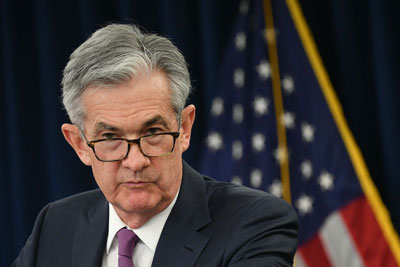Central banks set to flood market with cheap loans as trade war threatens to plunge global economy into recession
J. Johnson

- Analysts expect central banks in the US, India, Indonesia, South Korea and Malaysia to ensure ample liquidity if their economies show signs of weakening
- Traders expect a 70 per cent chance of a US rate cut in July; Hong Kong’s Linked Exchange Rate System to ensure HKMA moves lockstep with the Federal Reserve
The era of cheap funding is set to return as central banks worldwide cut interest rates to stimulate slowing growth amid an escalating global trade war that could tip the world economy into recession, according to analysts.
The chances of a global recession have risen after the US last month raised tariffs on US$200 billion worth of Chinese goods to 25 per cent from 10 per cent while threatening to impose tariffs on another US$300 billion more of Chinese goods. China hit back by raising tariffs on US$60 billion of US products from June 1. It has also cranked up the tension with major trading partners Mexico and India.
Analysts have cut China’s gross domestic product growth forecasts for this year, while the American business community is worried that the US will enter a recession next year, which could drag the global economy with it.
On Thursday, although the European Central Bank decided to leave its record-low interest rates unchanged, it left the door open for further rate cuts as the global trade war and Brexit weigh the euro zone economy down.

The Reserve Bank of Australia cut its key interest rate to a record low on Tuesday. Photo: AFP
But the first to act was the Reserve Bank of Australia. On Tuesday the Australian central bank announced its first rate cut in three years, reducing its cash rate by 25 basis points to a record low of 1.25 per cent.
“Growth in international trade remains weak and the increased uncertainty is affecting investment intentions in a number of countries,” RBA governor Philip Lowe said in a statement explaining the rate cut.
Analysts at ANZ said that they expect the RBA to cut rates two more times this year by another 50 basis points as the headwinds from the global economy look to be increasing. “A more negative global environment will likely impact the outlook for business investment, among other things. This means more easing is likely to be required in 2020,” said David Plank, head of Australian Economics of ANZ in a research note on Friday.

China’s central bank has reduced its reserve requirement ratio to boost lending to the country’s SMEs. Photo: Bloomberg
The Federal Reserve chairman Jerome Powell also said on Tuesday that the US central bank was closely monitoring the impact of the trade wars between the US with China as well as Mexico, and “will act as appropriate to sustain the expansion”.
The market has taken Powell’s remarks as an indicator of a possible rate cut, pushing the S&P 500 up 2.1 per cent on Tuesday.
The fed fund futures market shows traders see a 23 per cent chance of a rate cut at the Fed meeting on June 19 and a 70 per cent chance at its July 31 meeting, according to Jasper Lo, chief investment strategist at Hong Kong-based Eddid Securities and Futures.
The Fed rate now stands at between 2.25 per cent to 2.50 per cent after its latest 25 basis points increase in December.
A report from Morgan Stanley showed that China was expected to further reduce banks’ reserve requirement ratio to release liquidity into the banking system, while central banks in India, Indonesia, South Korea, Malaysia and the Philippines were all likely to cut rates between one and two times ranging from 25 to 50 basis points this year.
The People’s Bank of China has cut its RRR by 300 basis points this year, releasing 280 billion yuan (US$40.5 billion) in liquidity to support funding for small and medium enterprises which account for 60 per cent of the GDP and 80 per cent of jobs.

the US has imposed punitive tariffs on China and cranked up pressure on Mexico and India. Photo: Chinatopix via AP
“We expect another 100 to 200 basis points of broad-based RRR cuts over the rest of the year, along with the use of lending facilities and other new tools,” said Yifan Hu, regional chief investment officer and chief China economist of UBS in a report.
Morgan Stanley meanwhile has cut China’s full year GDP growth from 6.5 per cent to 6.4 per cent because of the trade war.
“If trade tensions continue to escalate, with the US imposing 25 per cent tariffs on the remaining US$300 billion of imports from China and China responding with countermeasures, we believe that the global cycle will be at risk. We could end up in a recession in three quarters,” Robin Xing, chief China economist of Morgan Stanley in a research report.
The Federal Reserve’s expected rate cut will put an end to the rising interest rate cycle of both the US and Hong Kong that started in December 2015. As the Hong Kong dollar is pegged to the US dollar, the Hong Kong Monetary Authority moves lockstep to any interest rate movement in the US.
"Growth in international trade remains weak and the increased uncertainty is affecting investment intentions in a number of countries" -Philip Lowe, governor, Reserve Bank of Australia
A HKMA spokeswoman did not comment on the possibility of an interest-rate cut, but said that the authority “will continue to ensure that the Linked Exchange Rate System is functioning effectively in accordance with its design”.
The HKMA’s base lending rate now stands at 2.75 per cent after the latest rate rise in December 2018, compared with 0.5 per cent before the first rate increase in the current cycle. Before 2015, the interest rate in the US and Hong Kong stayed close to almost zero for a decade as the central banks wanted to use the low interest rate to boost investments and economic growth after the global financial crisis in 2008.
Allianz Global Investors also expects global interest rates to stay low for an extended period.
“The ongoing US-China trade tension, Brexit uncertainty and liquidity tightening have created headwinds globally and in Asia,” said Neil Dwane, global strategist at AllianzGI, which has €535 billion (US$601 billion) assets under management. “Interest rates will be lower for a longer period.”
He said that amid such uncertainties, gold and cash may be a good hedging tool for investors.

Enoch Yiu joined the Post as a business reporter in 1996. Before that, she worked at a Chinese daily newspaper for four years. She is author of two books: 'They Mean Business: 50 exclusive interviews with Hong Kong top executives' and 'Serving with Passion: stories of established catering brands in Hong Kong'.
www.scmp.com
| 



